Secure and Efficient Message Authentication Scheme for 6G-Enabled VANETs
Abstract
:1. Introduction
- The ASMA scheme is ID-based and pairless, which costs less in terms of computational and communication overheads than schemes based on PKI and pairing operations. What is more, the secret key is not directly installed in the TPD, which ensures that the scheme is secure even when the TPD is stolen. In addition, the ASMA scheme can realize conditional privacy protection, i.e., vehicle identity privacy protection and traceability.
- In the PVBS scheme, a novel proxy vehicle selection algorithm is designed for the RSU to select proxy vehicles. The RSU coordinates the verification tasks and verifies them with the proxy vehicles at the same time, which solves the problem of redundant message verification as well as reducing the verification delay of the system.
- Performance analysis indicates that the ASMA scheme consumes less computation overhead when the number of messages is small; however, in the case of large-scale messages, the PVBA scheme shows obvious advantages in verification efficiency. Thus, the RSU can dynamically adjust and adopt the ASMA scheme or the PABM scheme according to the number of received messages and vehicles.
2. Related Work
3. Preliminaries
3.1. System Model
3.2. Security and Privacy Requirements
- Message authentication: the scheme should realize the message authentication and detect modification of the messages.
- Identity privacy preservation: the vehicle’s identity information must not be revealed through the transmitted messages.
- Traceability: once a dispute appears, the vehicle’s identity information can only be extracted by the TA.
- Unlinkability: the transmitted messages from the same vehicle cannot be linked by RSUs and malicious vehicles, i.e., the vehicle’s private information cannot be traced.
- Resistance to common attacks: the scheme should overcome common attacks such as impersonation attacks, modification attacks, replay attacks and stolen device attacks.
- Efficient performance: the scheme should have low communication and computation overheads.
3.3. Mathematical Assumptions
- Elliptic Curve Discrete Logarithm Problem (ECDLP): the elliptic curves finite cyclic group consisting of the prim order q and the generator P is . The ECDLP problem is that given and , for random , s must be computed.ECDLP Assumption: it is impossible for a probabilistic polynomial time (PPT) algorithm to handle the ECDLP with the negligible probability within the maximum time .
- Computational Diffie–Hellman Problem (CDHP): the elliptic curves finite cyclic group consisting of the prim order q and the generator P is . The CDH problem is that given and , for random , must be computed.CDHP Assumption: it is impossible for a PPT algorithm to handle the CDHP with non-negligible probability .
- One-Way Hash Function: the output of a secure one-way hash function is fixed, regardless of the length of the input.Hash Function Assumption: for any input z, it is easy to compute and infeasible to find the hash function which satisfies . In addition, for any input z, it is impossible to find , where .
4. Anonymous and Secure Message Authentication Scheme
4.1. The Proposed Scheme
- The TA selects an elliptic curve generated by , in which , and p is a large prime number.
- The TA selects a large prime q to construct a cyclic group on the elliptic curve , with generator P.
- The TA randomly chooses as the master key and computes , where is the public key.
- The TA selects three hash functions , and , in which l is the length of the vehicle’s real identity.
- The TA publishes the system parameters .
- Vehicle submits the identity and password to the TA through a secure channel, and then the TA checks their validity. If they are valid, the TA proceeds to the next step.
- The TA randomly selects and computeswhere is the partial secret and is used to generate the secret key of vehicle in the message signing stage. Then, the TA preloads the secret parameter to the TPD of vehicle .
- Vehicle randomly selects as the secret key and computes .
- Vehicle randomly chooses from the TPD and computesand
- The signature on is , and vehicle sends to the RUS, where is the current time.
- The RSU checks the freshness of . If the time has expired, the message will be rejected. Otherwise, it proceeds to the next step.
- The RSU computes and , then checks whether the equation holds. If true, the message is legal. Otherwise, the message is discarded.
- The RSU checks the freshness of , where , and discards the stale messages.
- In order to quickly detect modifications of these signatures, the RSU randomly selects a vector , where t is a small integer.
- The RSU computes and and checks whether the following equation is valid:If true, the messages pass through the verification. Otherwise, it indicates that an invalid message exists.
4.2. Security Analysis
- Message authentication: the RSU confirms the message tuple by verifying whether the equation holds. The ASMA scheme can realize message authentication.
- Identity privacy preservation: since the of vehicle is hidden in , and , the adversary extracts from by computing and . However, because the adversary has no knowledge of s and the hardness of the ECDLP, the adversary cannot obtain .
- Traceability: the of is hidden in . The TA can obtain by computing , since the TA possesses s and , .
- Unlinkability: to generate the signature of the message , firstly, vehicle selects to generate the pseudonym identity . Then, vehicle selects to compute and . Since and are randomly chosen, it is impossible for the adversary to link two pseudonym identities or two signatures sent by the same vehicles.
- Resistance to common attacks: the adversary must forge the right authentication tuple when impersonating a legal vehicle. However, according to the security proof mentioned above, it is impossible to forge a legitimate signature message in probabilistic polynomial time. Furthermore, the modification of the transmission message by adversary can be detected at the verification stage. To resist replay attacks, a time stamp was used in the design of the scheme. Since the secret key is not stored in the TPD directly, our scheme can withstand a stolen device attack. Thus, the ASMA scheme can withstand the common attacks, i.e., impersonation attacks, modification attacks, replay attacks and stolen device attacks.
4.3. Performance Analysis
- : the time for carrying out a BP operation , ms.
- : the time for carrying out a BP-related scale multiplication operation , where , ms.
- : the time for carrying out an ECC-related scale multiplication operation , where , ms.
- : the time for carrying out an ECC-related small-scale multiplication operation , where , ms.
5. Proxy-Vehicles-Assisted Batch Message Authentication Scheme
5.1. The Verification Process of the PVBA Scheme
5.2. The Verification Overhead of the PVBA Scheme
5.3. The Selection of Proxy Vehicles and the Computation of the Minimum Verification Overhead
| Algorithm 1 The Proxy Vehicles Selection Algorithm. |
| Input: The location list L, the extra resources J, the velocity V; Output: The minimal verification overhead ; Proxy vehicles list L;
|
5.4. Performance Analysis
6. Conclusions
Author Contributions
Funding
Institutional Review Board Statement
Informed Consent Statement
Data Availability Statement
Conflicts of Interest
References
- Xiong, W.; Wang, R.; Wang, Y.; Zhou, F.; Luo, X. CPPA-D: Efficient Conditional Privacy-Preserving Authentication Scheme with Double-Insurance in VANETs. IEEE Trans. Veh. Technol. 2021, 70, 3456–3468. [Google Scholar] [CrossRef]
- Wang, P.; Liu, Y. SEMA: Secure and Efficient Message Authentication Protocol for VANETs. IEEE Syst. J. 2021, 15, 846–855. [Google Scholar] [CrossRef]
- Zhou, H.; Xu, W.; Chen, J.; Wang, W. Evolutionary V2X Technologies Toward the Internet of Vehicles: Challenges and Opportunities. Proc. IEEE 2020, 108, 308–323. [Google Scholar] [CrossRef]
- Zhao, J.; Liu, J.; Yang, L.; Ai, B.; Ni, S. Future 5g-oriented system for urban rail transit: Opportunities and challenges. China Commun. 2021, 18, 1–12. [Google Scholar] [CrossRef]
- Osorio, D.P.M.; Ahmad, I.; Sanchez, J.D.V.S.; Gurtov, A.; Scholliers, J.; Kutila, M.; Porambage, P. Towards 6G-enabled internet of vehicles: Security and privacy. IEEE Com. Soc. 2022, 3, 82–105. [Google Scholar] [CrossRef]
- Raya, M.; Hubaux, J.P. Securing Vehicular Ad Hoc Networks. J. Comput. Secur. 2007, 15, 39–68. [Google Scholar] [CrossRef] [Green Version]
- Alrawais, A.; Alhothaily, A.; Yu, J.; Hu, C.; Cheng, X. Secure Guard: A Certificate Validation System in Public Key Infrastructure. IEEE Trans. Veh. Technol. 2018, 67, 5399–5408. [Google Scholar] [CrossRef]
- Ogundoyin, S.O. An autonomous lightweight conditional privacy-preserving authentication scheme with provable security for vehicular ad-hoc networks. Int. J. Comput. Appl. 2020, 42, 196–211. [Google Scholar] [CrossRef]
- Azees, M.; Vijayakumar, P.; Deboarh, L.J. EAAP: Efficient Anonymous Authentication with Conditional Privacy-Preserving Scheme for Vehicular Ad Hoc Networks. IEEE Trans. Intell. Transp. Syst. 2017, 18, 1–10. [Google Scholar] [CrossRef]
- Alazzawi, M.A.; Lu, H.; Yassin, A.A.; Chen, K. Efficient Conditional Anonymity with Message Integrity and Authentication in a Vehicular Ad-Hoc Network. IEEE Access 2019, 7, 71424–71435. [Google Scholar] [CrossRef]
- Anderson, R.J. Tamper resistance-a cantionary note. In Proceedings of the Second Usenix Workshop on Electronic Commerce 1996, Oakland, CA, USA, 18–21 November 1996; Volume 2, pp. 1–11. [Google Scholar]
- Cilio, W.; Linder, M.; Porter, C.; Di, J.; Thompson, D.R.; Smith, S.C. Mitigating power- and timing-based side-channel attacks using dual-spacer dual-rail delay-insensitive asynchronous logic. Microelectron. J. 2013, 44, 258–269. [Google Scholar] [CrossRef]
- Mahanta, H.J.; Azad, A.K.; Khan, A.K. Differential Power Analysis: Attacks and Resisting Techniques. Adv. Intell. Syst. Comput. 2015, 340, 349–358. [Google Scholar]
- He, D.; Zeadally, S.; Xu, B.; Huang, X. An Efficient Identity-Based Conditional Privacy-Preserving Authentication Scheme for Vehicular Ad Hoc Networks. IEEE Trans. Inf. Forensics Secur. 2015, 10, 2681–2691. [Google Scholar] [CrossRef]
- Lo, N.W.; Tsai, J.L. An Efficient Conditional Privacy-Preserving Authentication Scheme for Vehicular Sensor Networks Without Pairings. IEEE Trans. Intell. Transp. Syst. 2015, 17, 1319–1328. [Google Scholar] [CrossRef]
- Gayathri, N.B.; Gowri, T.; Vasudeva, R.P.; Ur, R. Efficient Pairing-Free Certificateless Authentication Scheme with Batch Verification for Vehicular Ad-hoc Networks. IEEE Access 2018, 6, 31808–31819. [Google Scholar] [CrossRef]
- Ferng, H.W.; Chen, J.Y.; Lotfolahi, M.A.; Tseng, Y.T.; Zhang, S.Y. Messages Classification and Dynamic Batch Verification Scheme for VANETs. IEEE Trans. Mob. Comput. 2019, 20, 1156–1172. [Google Scholar] [CrossRef]
- Hao, Y.; Yu, C.; Zhou, C.; Song, W. A Distributed Key Management Framework with Cooperative Message Authentication in VANETs. IEEE J. Sel. Areas Commun. 2011, 29, 616–629. [Google Scholar] [CrossRef]
- Sarencheh, A.; Asaar, M.R.; Salmasizadeh, M.; Aref, M.R. An Efficient Cooperative Message Authentication Scheme in Vehicular Ad-hoc Networks. In Proceedings of the 2017 14th International ISC (Iranian Society of Cryptology) Conference on Information Security and Cryptology (ISCISC), Shiraz, Iran, 6–7 September 2017; pp. 111–118. [Google Scholar]
- Zhang, C.; Lin, X.; Lu, R.; Ho, P.H.; Shen, X. An Efficient Message Authentication Scheme for Vehicular Communications. IEEE Trans. Veh. Technol. 2008, 57, 3357–3368. [Google Scholar] [CrossRef] [Green Version]
- Thumbur, G.; Rao, G.S.; Reddy, P.V.; Gayathri, N.B.; Reddy, D.V.R.K.; Padmavathamma, M. Efficient and Secure Certificateless Aggregate Signature-Based Authentication Scheme for Vehicular Ad Hoc Networks. IEEE Internet Things J. 2020, 8, 1908–1920. [Google Scholar] [CrossRef]
- Wang, Y.; Zhong, H.; Xu, Y. Enhanced Security Identity-Based Privacy-Preserving Authentication Scheme Supporting Revocation for VANET. IEEE Syst. J. 2020, 14, 5373–5383. [Google Scholar] [CrossRef]
- Zhao, J.; Sun, X.; Li, Q.; Ma, X. Edge Caching and Computation Management for Real-Time Internet of Vehicles: An Online and Distributed Approach. IEEE Trans. Intell. Transp. Syst. 2021, 22, 2183–2197. [Google Scholar] [CrossRef]
- Zhao, J.; Ni, S.; Yang, L.; Zhang, Z.; Gong, Y.; You, X. Multiband cooperation for 5g hetnets: A promising network paradigm. IEEE Veh. Technol. Mag. 2019, 14, 85–93. [Google Scholar] [CrossRef]
- Zhao, J.; Li, Q.; Gong, Y.; Zhang, K. Computation offloading and resource allocation for cloud assisted mobile edge computing in vehicular networks. IEEE Trans. Veh. Technol. 2019, 68, 7944–7956. [Google Scholar] [CrossRef]
- Liu, Y.; Wang, L.; Chen, H.H. Message Authentication Using Proxy Vehicles in Vehicular Ad Hoc Networks. IEEE Trans. Veh. Technol. 2015, 64, 3697–3710. [Google Scholar] [CrossRef]
- Cui, J.; Wei, L.; Zhang, J.; Xu, Y.; Zhong, H. An Efficient Message-Authentication Scheme Based on Edge Computing for Vehicular Ad Hoc Networks. IEEE Trans. Intell. Transp. Syst. 2018, 20, 1621–1632. [Google Scholar] [CrossRef]
- Wu, F.; Zhang, X.; Zhang, C.; Chen, X.; Liu, Y. Batch-assisted Verification Scheme for Reducing Message Verification Delay of the Vehicular ad hoc Networks. IEEE Internet Things J. 2020, 7, 8144–8156. [Google Scholar] [CrossRef]
- Zhao, J.; Yang, L.; Xia, M.; Motani, M. Unified Analysis of Coordinated Multi-Point Transmissions in mmWave Cellular Networks. IEEE Internet Things J. 2021, 9, 12166–12180. [Google Scholar] [CrossRef]
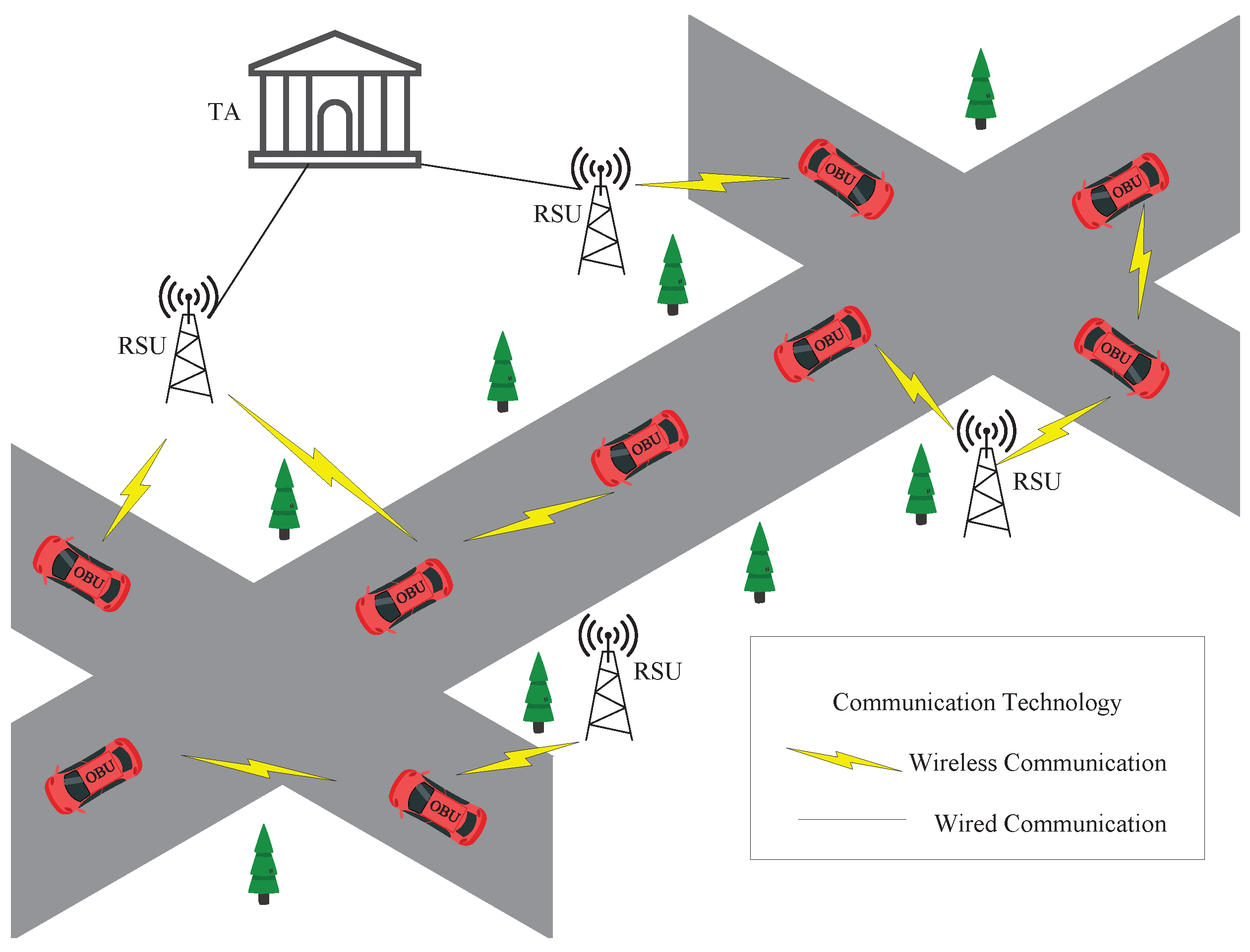
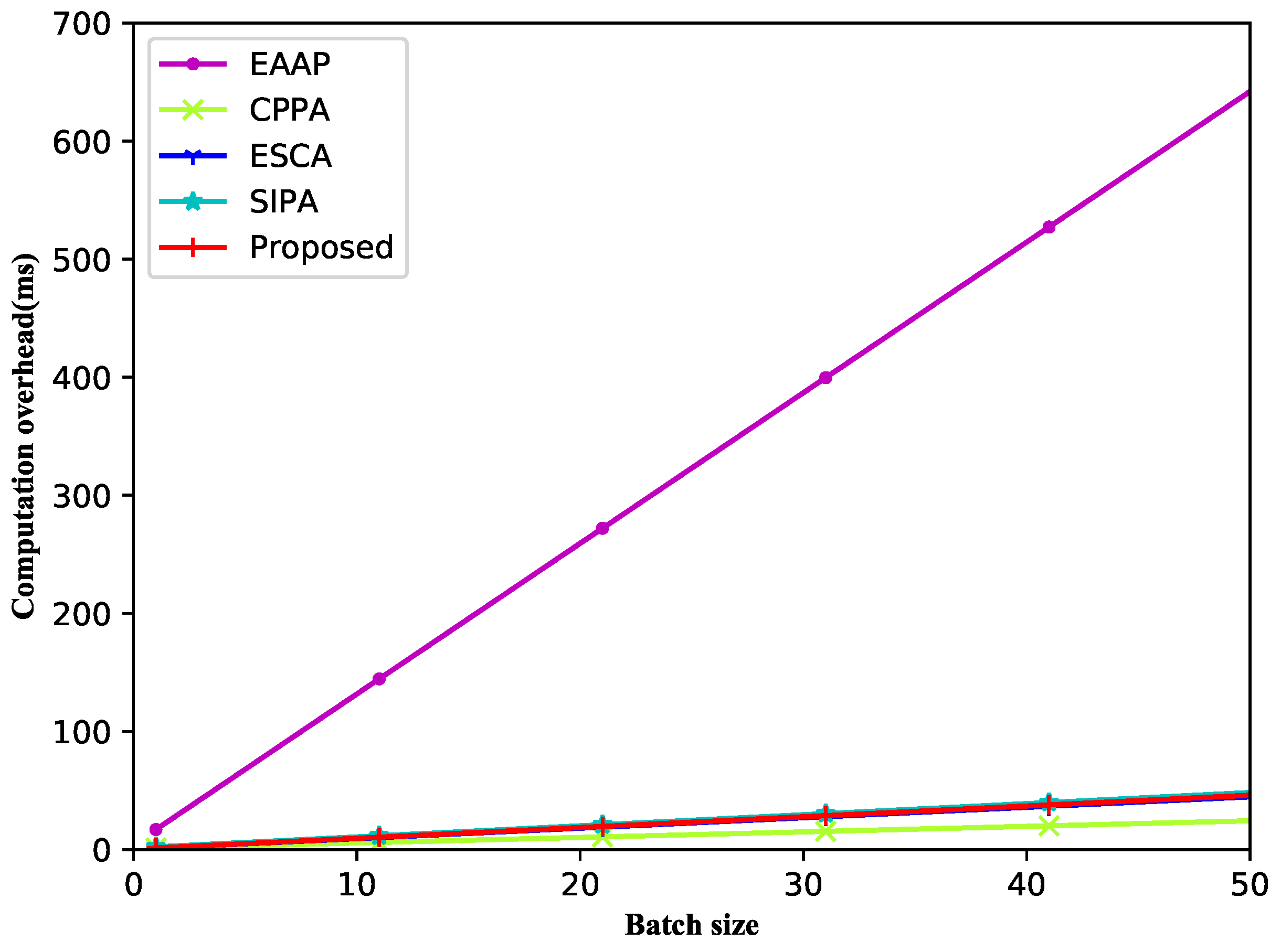
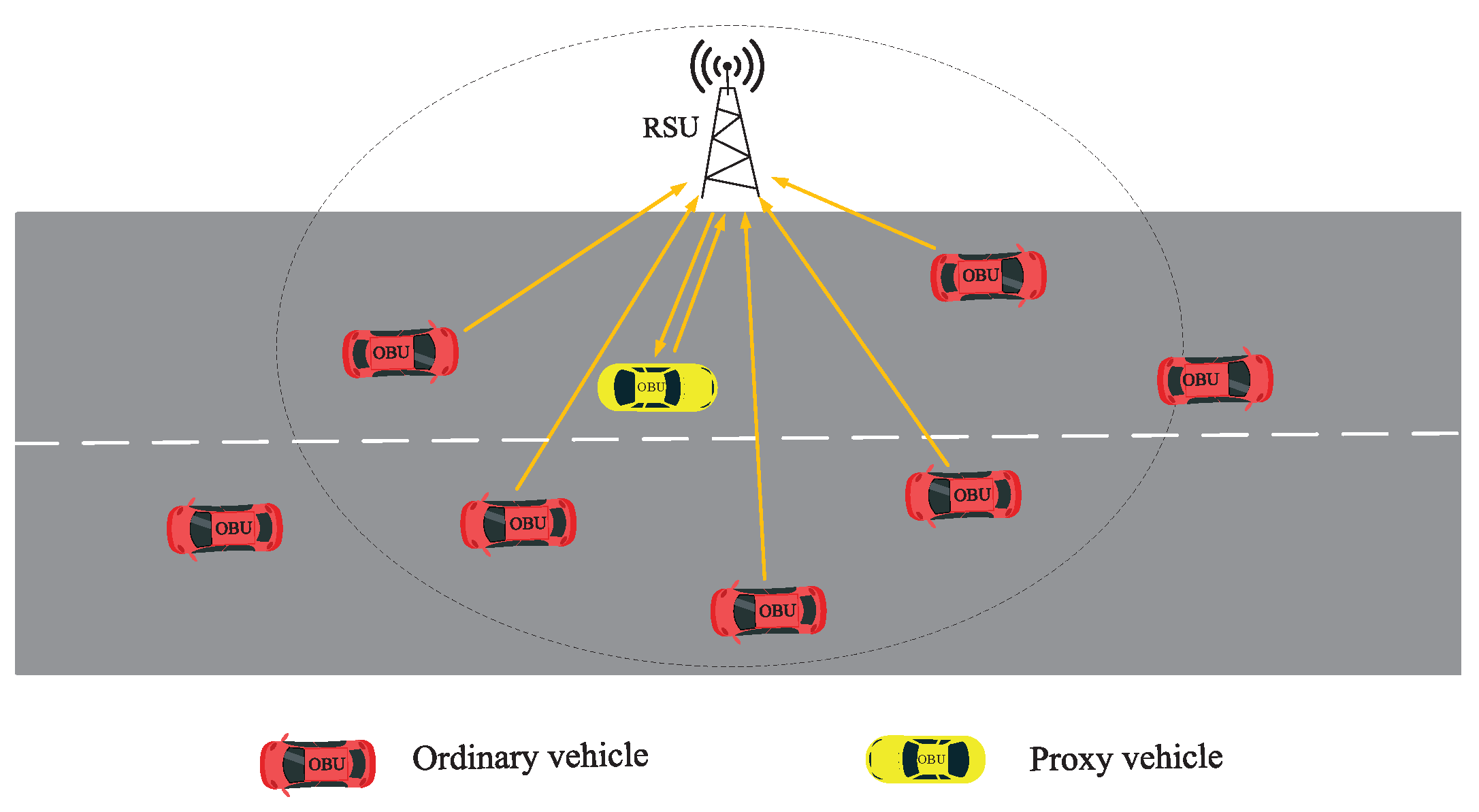
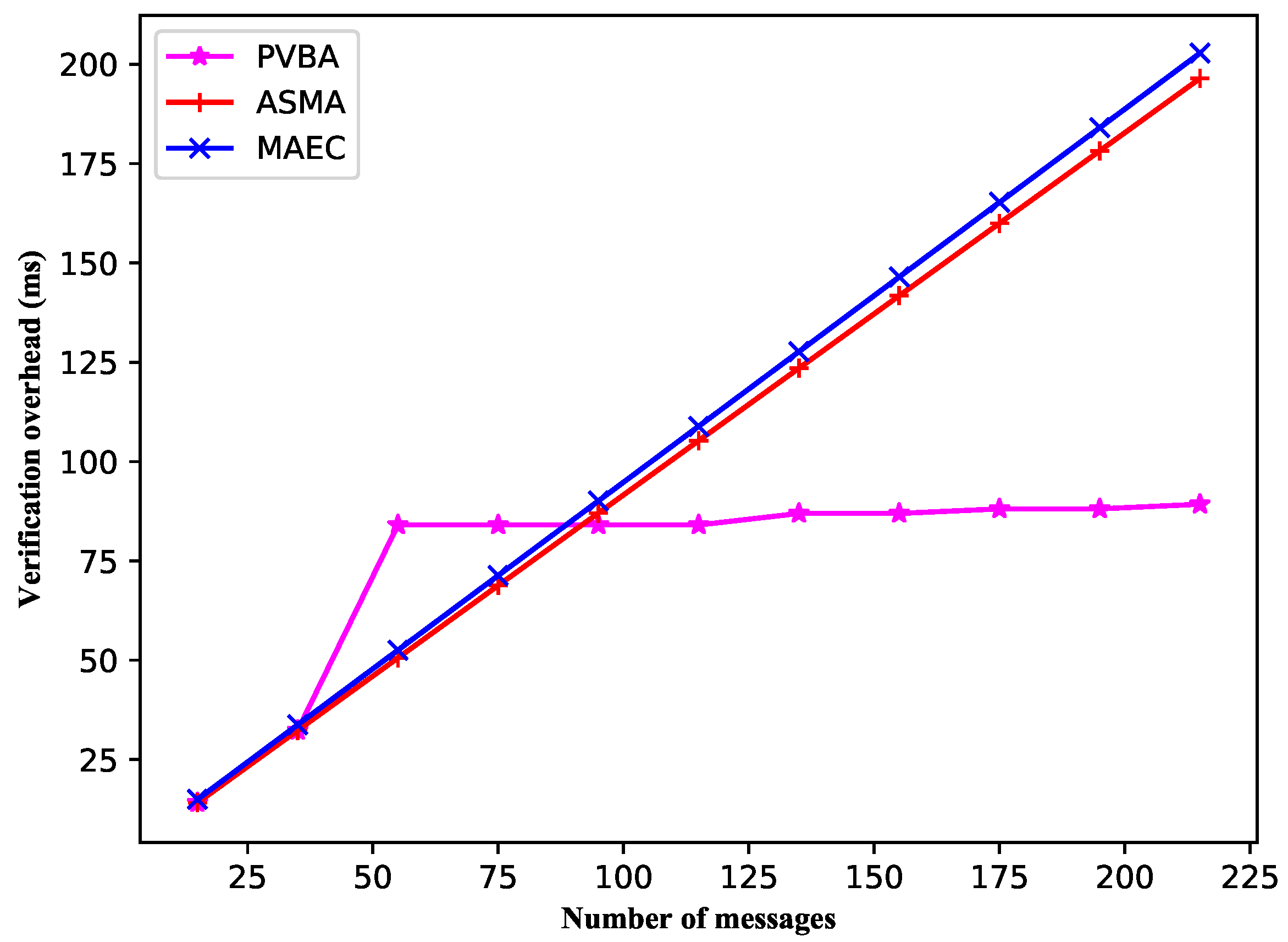
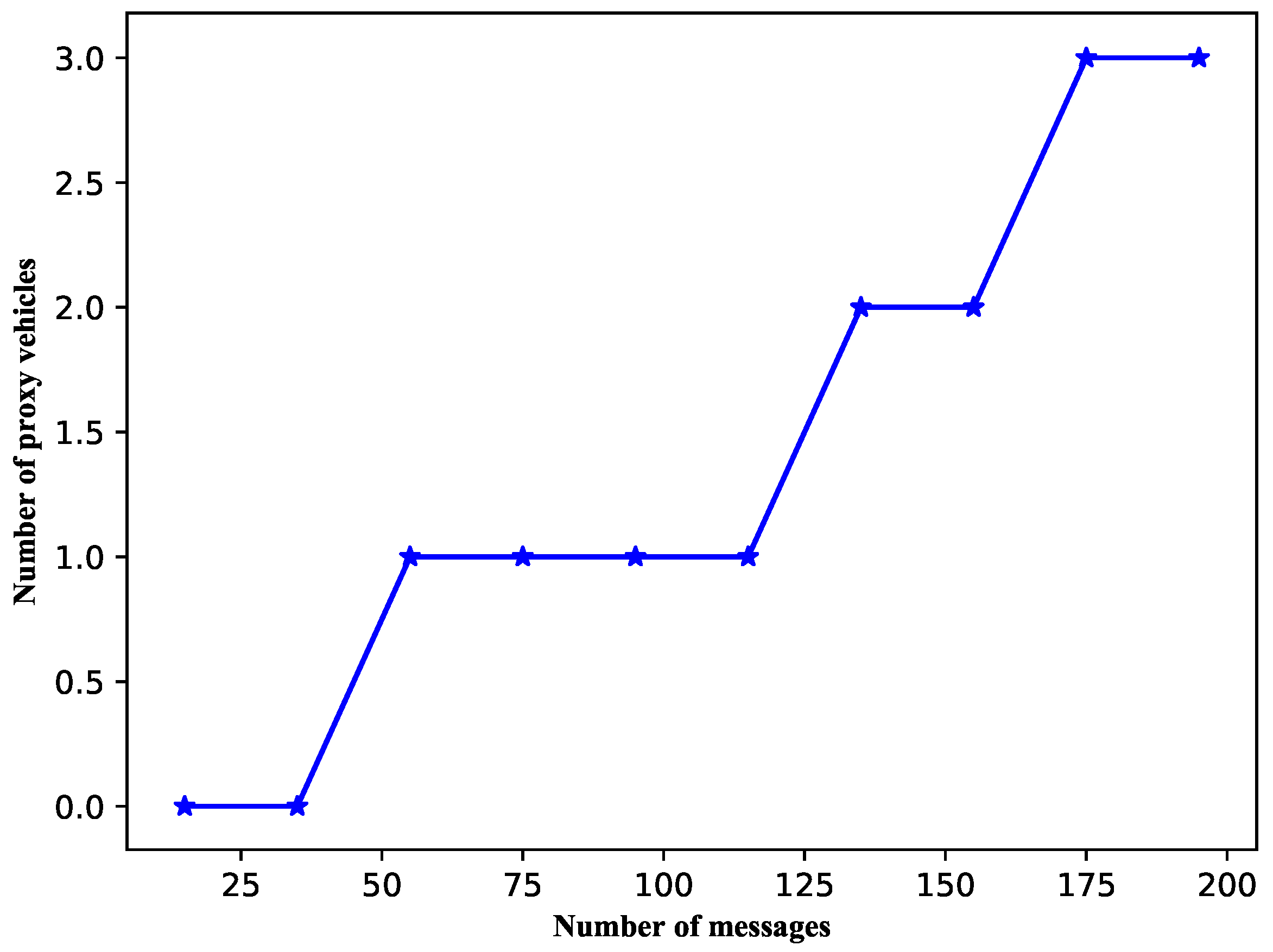
Publisher’s Note: MDPI stays neutral with regard to jurisdictional claims in published maps and institutional affiliations. |
© 2022 by the authors. Licensee MDPI, Basel, Switzerland. This article is an open access article distributed under the terms and conditions of the Creative Commons Attribution (CC BY) license (https://creativecommons.org/licenses/by/4.0/).
Share and Cite
Liao, L.; Zhao, J.; Hu, H.; Sun, X. Secure and Efficient Message Authentication Scheme for 6G-Enabled VANETs. Electronics 2022, 11, 2385. https://doi.org/10.3390/electronics11152385
Liao L, Zhao J, Hu H, Sun X. Secure and Efficient Message Authentication Scheme for 6G-Enabled VANETs. Electronics. 2022; 11(15):2385. https://doi.org/10.3390/electronics11152385
Chicago/Turabian StyleLiao, Longxia, Junhui Zhao, Huanhuan Hu, and Xiaoke Sun. 2022. "Secure and Efficient Message Authentication Scheme for 6G-Enabled VANETs" Electronics 11, no. 15: 2385. https://doi.org/10.3390/electronics11152385
APA StyleLiao, L., Zhao, J., Hu, H., & Sun, X. (2022). Secure and Efficient Message Authentication Scheme for 6G-Enabled VANETs. Electronics, 11(15), 2385. https://doi.org/10.3390/electronics11152385







